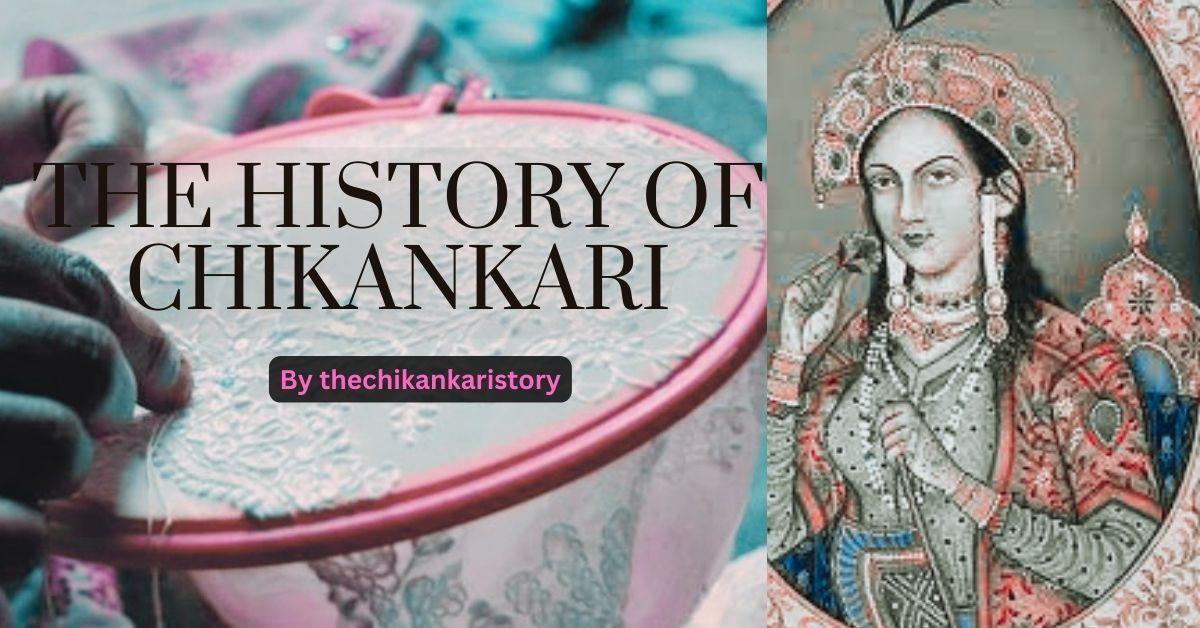The Chikankari Embroidery History:
Lucknowi Chikankari is a traditional embroidery style that originated in the northern Indian city of Lucknow. This delicate and intricate embroidery has a rich history and has been a part of the cultural heritage of Lucknow for centuries.
The Chikankari Embroidery History can be traced back to the Mughal era in the 16th century. It was during this time that the art of embroidery was introduced to India by Persian and Turkish invaders. Interestingly, the word ‘Chikankari’ is derived from the Persian word ‘Chikan,’ which means ‘embroidery.’

Moving forward, the art of Lucknowi Chikankari became popular during the reign of the Nawabs of Awadh in the 18th and 19th centuries. The Nawabs were great patrons of the arts and promoted the development of this embroidery style. As a result, the embroidery started to incorporate elements of the local culture and the intricate patterns of Lucknowi Chikankari were born.
In conclusion, Chikankari Embroidery History is a testament to the rich cultural heritage of Lucknow. Over time, the popularity of this intricate embroidery style continued to grow. To own a piece of history, you can shop for authentic Lucknowi Chikankari items from trusted retailers who value this beautiful embroidery style. So, go ahead and add a touch of elegance and tradition to your wardrobe with Lucknowi Chikankari.
Traditional Embroidery Techniques
Traditional Embroidery Techniques: A Celebration of Our Cultural Heritage
In this article, we will explore some of the most popular traditional embroidery techniques and their origins.
Cross-Stitch Embroidery: A Timeless Classic
Moreover, cross-stitch is one of the oldest and most widely used forms of embroidery. It originated in Europe in the 6th century and quickly spread to other parts of the world. This technique involves creating X-shaped stitches using a needle and thread to form a pattern on fabric.
Additionally, the stitch can be worked in a variety of ways to create different effects, from simple to complex designs.

Crewel Embroidery: A Three-Dimensional Art Form
Another popular traditional embroidery technique is crewel embroidery, which originated in the Middle East in the 16th century. This technique uses wool thread to create intricate designs on fabric. Crewel embroidery is known for its raised, three-dimensional appearance, and it is often used to create decorative items such as cushions, wall hangings, and tablecloths.

Sashiko Embroidery: A Japanese Tradition
Sashiko embroidery is a traditional Japanese technique that has been used for centuries to repair and decorate textiles. It involves using a running stitch to create geometric patterns on fabric. Originally, sashiko was used to reinforce clothing and other textiles, but it has since become a popular decorative technique in its own right.

Chikankari Embroidery: Elegant and Understated
In India, the traditional embroidery technique of chikankari has been used for centuries to create delicate, white-on-white designs on cotton fabric. Chikankari involves creating intricate patterns using a combination of running stitch, satin stitch, and stem stitch. The result is a beautiful, textured design that is both elegant and understated.

Conclusion: Connecting with Our History through Embroidery
Traditional embroidery techniques are an important part of our cultural heritage. They have been used for centuries to create beautiful, intricate designs on various textiles. From cross-stitch to crewel embroidery, sashiko to chikankari, each technique has its own unique history and style.
By carrying on traditional embroidery techniques, we can preserve our cultural heritage and encourage its growth and evolution for generations to come. As a result, traditional embroidery is not only a way to create art, but also a way to honor and celebrate the diversity of our cultural traditions.
Thus, it is essential to continue to support and promote traditional embroidery techniques to keep our cultural heritage alive.
Significance of Lucknowi Chikankari Embroidery:
The significance of Lucknowi Chikankari embroidery lies in its intricate detailing and timeless appeal. Skilled artisans carefully craft each stitch to create patterns that evoke elegance and sophistication.
Furthermore, the embroidery work is often highlighted with a combination of white and pastel colors, which adds to its beauty. Through this technique, artisans not only showcase their skill and creativity, but also reflect the rich cultural heritage of the region.


We will explore the significance of Lucknowi Chikankari embroidery and why it is cherished by so many people.
A Reflection of the Lucknowi Culture
- Lucknowi Chikankari embroidery reflects the city’s culture, with designs inspired by its architecture, flora, and fauna.
Versatile and Elegant
- The embroidery is versatile and can be used on a variety of fabrics, adding elegance and sophistication to any outfit.
Supporting Local Artisans
- Lucknowi Chikankari embroidery is a source of livelihood for many artisans in the city. Purchasing these products supports the local economy and preserves the traditional art form.
Global Popularity
- This embroidery style has gained worldwide popularity, with celebrities and fashion designers incorporating it into their collections. The increased demand has created job opportunities for many artisans.
Buy Online Lakhnawi Chikankari Embroidery Kurta and Kurtis for Women at the Best price
Lakhnawi Chikankari Kurti for Women at an Affordable Price
When it comes to traditional Indian clothing, Lakhnawi Chikankari Kurtis are known for their elegance and beauty. These Kurtis are not only stylish and fashionable but also made with the finest quality materials. As a result, they are comfortable to wear and perfect for any occasion.
Therefore, if you’re looking for Lakhnawi Chikankari Kurtis at a low price, be sure to check out our e-commerce website today.




